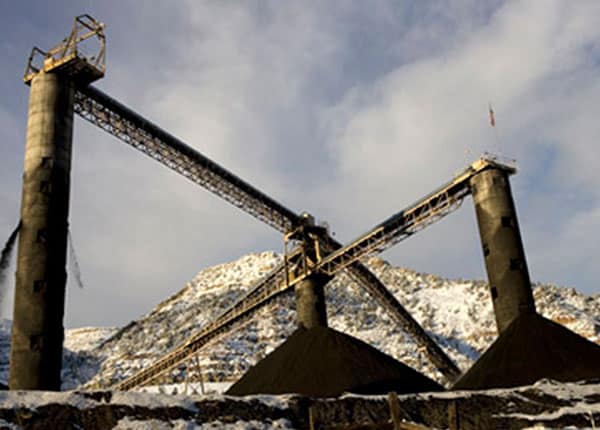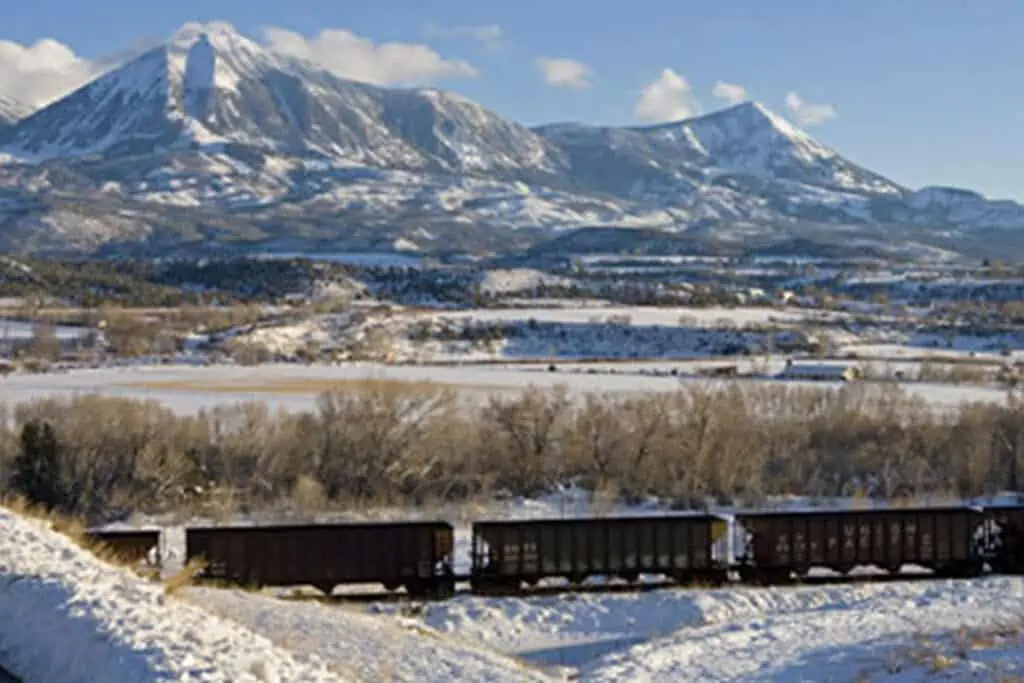ENERGY PRODUCTION IN THE NORTH FORK VALLEY: COAL MINING AND NATURAL GAS DRILLING
By Ranch Real Estate Broker Gary Hubbell © 2009 All Rights Reserved
When it comes to the current national conversation about clean energy, greenhouse gases, carbon loading, and global warming, coal mining certainly takes its lumps. However, the truth is that coal provides cheap, abundant energy for such essential uses as producing electricity, smelting steel, and heating homes. Colorado’s North Fork Valley is home to three coal mines that can employ up to 1,300 miners all told, and it’s an important part of the economy in a rural Colorado area with no other major industries other than agriculture and tourism. In recent years, coal bed methane drilling has begun to take place in the same geologic formations that contain mineable coal, and natural gas production is also an important Western Colorado industry that is beginning to make its mark in the North Fork Valley. Coal from the North Fork Valley feeds several major western power plants, but it’s also just as likely to be exported to any of a dozen or more foreign countries via a network of loading docks and ocean freighters.
SOMERSET, COLORADO: HOME TO BOWIE, OXBOW, AND WEST ELK MINES
The three mines in the North Fork Valley are aligned along the North Fork of the Gunnison River, beginning a few miles east of Paonia with the Bowie Resources mine, then the Oxbow mine, and culminating with Arch Coal’s West Elk mine one mile east of Somerset.
The mines produce what is known as Uintah coal from the Western Bituminous Region. They produce high-quality bituminous coal that is known for a high energy content (11,000 BTU per pound), and a low content of ash, sulfur, and mercury. The North Fork coal is ideal for electric power generation and meets all environmental standards, so it is highly sought after. The mines are situated along mountain ridges of Mancos Shale interspersed with seams of coal, and utilize both private leases and U.S. Forest Service lands that have been leased to the mines for coal production. All three mines use what is known as the longwall mining system and use continuous miners to extract the coal, and they produce quite a lot of it. In 2008, the mines collectively produced over 15 million tons of coal. All three mines are underground mines; no strip mining is conducted in the North Fork Valley.

THE WEST ELK MINE, SOMERSET, COLORADO
The West Elk Mine is located a mile to the east of Somerset, and employs up to 350 people. Owned by Arch Coal, the nation’s second largest coal producer, Arch supplies fuel for approximately 8% of the nation’s electricity through a network of mines in West Virginia, Kentucky, Wyoming, Utah, Virginia, and Colorado.
OXBOW RESOURCES’ ELK CREEK MINE, SOMERSET, COLORADO
The Oxbow mine, as it is known, is located north of Somerset, and the coal loading docks are right next to Highway 133 as it snakes it way through the small coal-mining town. The mine produces 6 million tons of high-quality bituminous coal annually.
BOWIE RESOURCES COAL MINE, PAONIA, COLORADO
The Bowie mine (rhymes with “Howie”) is located just east of Paonia and north of Highway 133. The Bowie mine has a total of 80 million tons of coal reserves, and annual production has reached 6 million tons. Bowie employs about 350 miners.
A CHALLENGING ENVIRONMENT TO MINE COAL AND DRILL FOR GAS
The North Fork Valley is known for its sandstone, shale, and sedimentary geologic formations, and many of the strata are soft and unstable where coal seams are found. Fractures and faults in the geologic strata are common, which make it difficult to mine. For example, “bumps” and shifts are common, and methane can escape from a neighboring coal seam via a fracture into the mine chamber, poisoning the air and creating an explosive environment. Consequently, innovative and meticulous mine engineering is critical to mining success in the North Fork Valley.
Just over the mountain from the Somerset mines, the mines at Redstone were known for producing outstanding coal in one of the most challenging environments. Despite the great quality of the coal, the mines were ultimately permanently closed in the late 1980’s because of the high cost of mining and dangerous conditions. The North Fork mines are not quite so dangerous and difficult, but mining in the North Fork requires caution and careful planning.
COAL MINING—WOVEN INTO THE COMMUNITY FABRIC
One might wonder how mining fits into a community of Rastafarians, artists, cowboys, ranchers, loggers, musicians, organic farmers, vintners, and orchardists, and displaced ski bums seeking refuge from Aspen and Crested Butte. The answer is, quite well, thank you very much. Coal mining has been a tradition here since the 1890’s, and just as you might have to wait for a rancher to drive his cattle down the highway, you’ll have to wait for a coal train to cross the highway. Everyone is here to make a living, and you’ll see deer grazing peacefully in apple orchards next to the coal silos. Your flooring contractor might be a coal miner working the graveyard shift, and you might have to consider that he got off work at 7 a.m. before you call about the new wood floor you want to install. Four p.m. might be a much better time.
EMPLOYMENT AND ECONOMIC IMPACTS OF COAL MINING IN THE NORTH FORK VALLEY
In a valley where the biggest town is still smaller than 2,000 residents, an industry that provides upwards of 1,000 high-paying jobs is an economic mainstay in the North Fork Valley. Experienced miners can make upwards of $85,000 a year when benefits are included, and shifts are often structured so that miners work three weeks and then get a week off. The down time from mining offers employees a chance to enjoy the recreational benefits of the North Fork Valley, such as elk and deer hunting, camping, fishing, boating, snowmobiling, skiing, horseback riding, and four-wheeling. Many miners have secondary incomes, such as construction, farming, horse training, or welding. Altogether, the miners’ work schedule allows a hard-working miner plenty of time off to either supplement his income or have a good time with his family.
CLEAN ENERGY, GREEN ENERGY, COAL, AND GAS
Ask any coal miner, and he’ll freely admit that coal isn’t the cleanest energy, and we should be doing everything we can to develop solar, wind, nuclear, and other energy sources. In the meanwhile, however, coal is abundant, relatively cheap, and beats the heck out of importing oil from countries in the Middle East that also support terrorists. North Fork Valley coal has a low sulfur content, high energy values, and is considered clean-burning among coal sources. The next wave of energy development—natural gas—is very clean-burning and consistent. If there are any environmental drawbacks, it is in the extraction process, where road cuts, drilling pads, wastewater runoff, and wildlife disturbances are the major issues.
While it’s impossible to conceal a major coal mine employing 350 people, the mines in the North Fork Valley are well run and environmentally conscious. Ground water monitors are installed, and regular tests are taken of water quality in the streams and rivers near the mines. Slag piles are covered with topsoil and re-vegetated. Given the major energy resource, the footprint isn’t all that great, and it’s simply another aspect of living in the North Fork Valley.
What are miners like? Well, they’re like any other group of people. They’re hardworking, loyal, patriotic people concerned about their families, their country, and their neighbors. Some are highly educated with engineering degrees, and others have only a GED. As a group, they’re proud people who work hard for a living in a dangerous job.
FUTURE ENERGY PRODUCTION IN THE NORTH FORK VALLEY
Some of the more easily accessible coal seams in the North Fork Valley have already been mined. Future expansion of the mines often depends on obtaining new U.S. Forest Service mining permits. One or more of the mines may be in danger of running out of coal in the next decade or so. However, the nation’s energy demands are high, and coal will continue to play a prominent role in dependable energy production. If there is any rising star in energy production, it will be coal-bed methane gas drilling. A two-foot seam of coal may be impossible to mine, but if the methane can be captured via natural gas drilling, it provides a low-sulfur, clean-burning source of energy. Gas drilling is coming to the North Fork Valley, particularly on the north side of Highway 133, where the southern edge of the Piceance Formation provides seams of gas-bearing strata, and the infrastructure and pipelines built for the Rifle/Battlement Mesa areas on the west-central part of the state provide an outlet for distant markets.
ENERGY FORECAST FOR WESTERN COLORADO
With the economic downturn of 2008 and 2009, energy demand slumped, and not nearly as many coal trains left the North Fork Valley for distant markets. However, with a cold winter forecast for 2009-2010, natural gas prices are up, and consequently coal prices are up as well. As of November 2009, many analysts are predicting the end of the global downturn, and energy demand is predicted to increase. North Fork Valley coal mines were forced to lay off 130-some miners in June 2009, but the good news is that no further layoffs had occurred as of November 2009. The employment picture continues to look good, as homes need to be heated, people need electricity, and gas drilling will increase in Delta County.
As a real estate broker, I recognize the need for energy exploration and development, but I am also a strong supporter of reclamation, renewable energy sources, and a “leave no trace” ethic of using our public lands. Coal mining is an important part of the North Fork Valley’s economy, work ethic, and family tradition. I’ll do my part to assist families in relocating, finding the right property, and being part of the hard-working tradition of mining, ranching, timber production, and tourism of the North Fork Valley.

